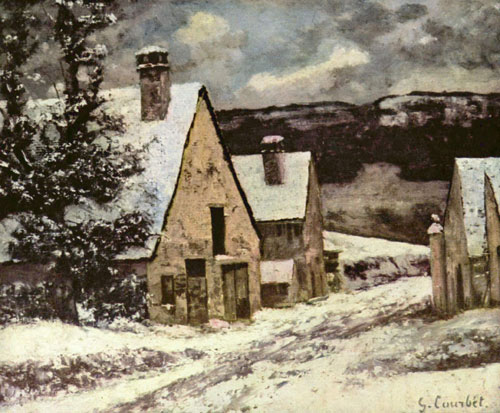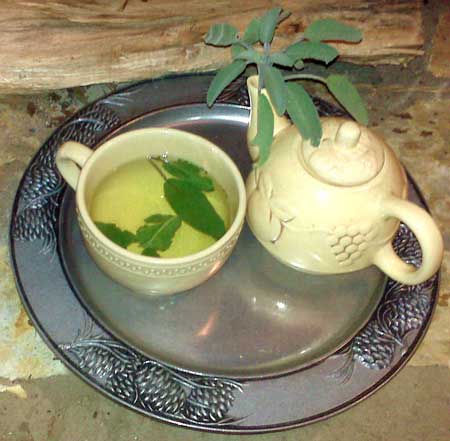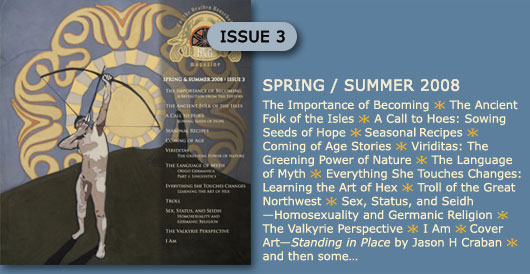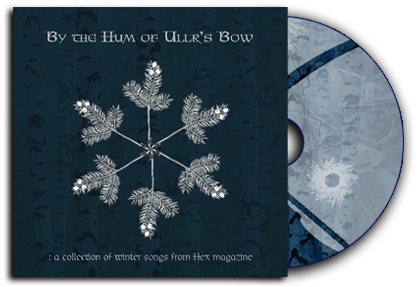~ THE TURNING OF THE WHEEL ~
Yule/Winter Solstice 2010
Support Hex! We are community-supported not-for-profit publication. You can support us by heading to http://hexmagazine.com/subscribe/ and ordering magazines, CDs, and prints, and by spreading the word to all like-minded folk!
* * * * * *
* Hex Folk Market is Here! *
The much anticipated Hex Folk Market (www.hexfolkmarket.com) is here! Join our online market community in celebration of folk ways and sustainable living. Browse through our selection of international merchants or set up your own shop for free!
* * * * * *

Dorfausgang im Winter by Gustav Courbet, 1819-1877
Brew me a cup for a winter’s night.
For the wind howls loud and the furies fight;
Spice it with love and stir it with care,
And I’ll toast our bright eyes,
my sweetheart fair.
~Minna Thomas Antrim
* * * * * *

A cup of hot sage tea!
Winter Solstice and Mutterkraut1
Winter Solstice arrives this year with a rare full lunar eclipse. Start looking tonight about 1:30am EST if you want to watch the show. Several cold snaps in the last few weeks have already killed off most of the worts around the yard and garden, and the woods are growing thin with their loss of live underbrush. Other areas across the United States are seeing lots of snow or rain – cold weather is here to stay for a while. With this season and its weather more coughs, colds, sniffles and sore throats begin to show up. For Pine Cone Hearth this means it’s time for sage tea.
Sage tea was one of the first worts to enter into my own Hedgewife’s Leechdom. I first read about sage as a teenager, I could relate to sage – I’d actually heard of and eaten it! Just the sound of the word brings back warm and fuzzy feelings from some of the family’s most festive fall and winter dinners. So I looked into this herb further.
The Romans brought common sage, an herb they held sacred and gathered with ceremony and sacrifice without iron tools, to the British Isles and Northern Europe from Mediterranean regions. Besides using it as a medicinal herb they thought it improved the mind and helped prolong life!
“How can a man die with sage in his garden?”
– Old saying from Middle Age Europe
Ancient Heathens had similar worts and embraced common sage for use in food preparation and preservation, as a medicinal, and as a magical ingredient.
“Eat sage in May, and you’ll live for aye.”
– Old English saying
Common Sage is a member of the large Mint Family with hundreds of sage cousins found all over the world. It’s also known as garden or kitchen sage, Latin Salvia officinalis, from the Latin salvere, to be saved, or safe, which refers to its medicinal properties. The Old English, Sawge may be the origin of our name sage. The name Officinalis turns up in several Latin plant names and refers to something saved, or a storeroom or pharmacy. In other words sage should be in any herbal medicine cabinet.
A long life was “attributed to sage tea in spring and fall, to sage sandwiches for supper, and to chopped sage in their porridge.”2
We started making sage tea for sore throats and coughs and it seemed to work well. The flavor was a bit strong but it was meant to be medicinal and mostly we just used it as a gargle. Turns out several old leechdoms mention sage as a gargle for sore throat and sore mouths, as well as a wash and poultice for skin infections. Another attribute of sage noted throughout history is its helpfulness for memory and healthy aging.
Sage “is singular good for the head and braine, quickeneth the sences and memory, strenghthenth the sinews, restoreth health to those that have the palsie.”
– John Gerard, 1545-1611/12, English herbalist
Today experiments are proving that sage and many other herbs are high in antioxidants and a variety of other active constituents useful for a variety of medicinal purposes. It may be useful as a powerful antiseptic, which helps wounds heal and resist infection both inside and outside the body. There is evidence that suggests that sage may even be effective in MRSA bacterial infections and useful in treating Alzheimer’s disease!
SAGE INFUSION: To mix up a cup of sage infusion tea, pour nearly boiling water over fresh or dried sage and allow it to steep for about 10 minutes before filtering, if needed. Drink or gargle with 2 or 3 cups a day. Add fresh or dried sage, 3 to 6 macerated fresh sage leaves, or a heaped teaspoon of rubbed or ground sage, to 1 cup of water. The flavor is medium to mild with a real earthy feel; we prefer the fresh sage leaves (when we have it) for its flavor and because we don’t have to filter out the herb. Many recipes note that you can add sweetener such as honey or improve the flavor by adding a bit of lemon or lime. I prefer lemon, but honey is nice when a sore throat is involved. You might also try mixing it with chamomile tea.
Sage is a perennial that is easy to grow in the garden and somewhat harder to grow in a pot. The plants should be restarted or replaced every few years to refresh the roots and keep the sage healthy. Harvest 1/3 of the top growth in early summer just before the flowers stalks start to appear, which are also edible and nice in salads. A few leaves can be harvested at any time, just be sure to leave enough leaves to keep it healthy through the winter. Many American varieties can also be found.
Sage is considered safe but should be avoided by pregnant and lactating women as one of its uses is to trigger late menstruation and to slow and stop breast milk flow.
This year when colds and coughs start to take over your hearth, save some money and try a medicine your grandmothers probably used, one that’s been around a while and is probably already in your kitchen – Sage, it’s good stuff!
Have a safe and happy Yule season!
~ Teresa L. Hedgewife
1. Claudia Muller-Ebeling, Christian Ratsch, Work-Dieter Storl, Witchcraft Medicine, trans. Annabel Lee (Rochester: Inner Traditions, 2003) 125 – 126.
2. Frederick O. Anderson, How to Grow Herbs for Gourmet Cooking (New York: Meredith Press, 1967) 25.
* * * * * *

•MANNAZ•
Old English Rune Poem
Monn (Man) is, in his mirth, to his kinfolk dear;
Yet shall each disappoint the other,
Accordingly the Lord wills, by his law,
That the poor flesh be entrusted to the earth
Old Icelandic Rune Poem
Madhr (Man) is man’s pleasure
And mould’s increase
And a ship’s embellisher
Old Norse Rune Poem
Madhr (Man) is mould’s increase;
Great is the grip of the hawk
~ Rune poem translations by Sweyn Plowright
http://www.mackaos.com.au/Rune-Net/Primer/
One of the mysteries of life that Mannaz turns toward is this: how do we keep going despite all the hardships of life? Whether it is the small daily challenges and struggles that we must overcome as a matter of course; or those times of crisis or loss when the world seems turned on its head – how do we keep going? Indeed, how do we not only survive but thrive?
The statement that man is “mould’s increase” amounts to declaring that entropy, loss, and things falling apart are all an inevitable part of living life. Does it make sense to give up because we always carry demise around with us? Of course not! Perhaps we will inevitably “disappoint” one another with our mortality or our limitations…but that doesn’t diminish the power of the mirth and pleasure that we can also share.
To be presented with this rune is, despite its macabre character, actually an encouraging thing. It is an opportunity for an infusion of the things that make life worth living. Mannaz says: “life can be short and hard.” And therefore, implicitly it is telling us to extract every last drop of satisfaction that we can. How else may we honour the love of our “kinsfolk, dear,” our community, our sense of place?
I really think it takes incredible courage to be a human being. When you stop and reflect on our precarious mortality you realise that we really are small and vulnerable in this huge and threatening world around us. It is that very vulnerability that provokes and necessitates our love of others, our creative passion, our curiosity, our desire for growth.
Without the grip of death’s hawk hovering, ever present, above us, we would not have the impetus to create any of the riches (be they trivial or great) that our shared lives yield: love, fellowship, understanding, and laughter.
There really is, then, every reason to look upon even our demise with optimism. Our poignant mortality gives us love, passion, and hope. The price we pay, that our flesh “be entrusted to the earth” in death, is actually a bargain if we are willing to accept it.
For this is the curious paradox: in death I am absolutely individualised and no one else can do my dying for me, yet my mortality binds me in common nature to all those around me. When we reflect on death we can find ourselves called back to our own true spirit and desires, and often this call invokes our need and love of others.
In other words: by means of death, the great destroyer, we find both our deepest passions and our desire for the joys of friendship, family, and community. Death holds the threat of unbearable loss over our heads, but it also enables us to grant one another solace and thus live lives far richer than we could otherwise hope to enjoy.
Mannaz invites us to ask: what is there to celebrate in my life? What is there to share? How can I show my gratitude to those I love? How can I better heed my own heart? How might I heal the wounds that life inevitably inflicts? How may I honour this ironic world that so freely gives life and so freely takes it?
When we serve to enrich one another’s’ lives, becoming mutual mirth and pleasure, we loosen the grasp of our own flaws and mortality, even if only for a while. I cannot think of a better way to taste immortality.
* * * * * *
Ironwood Presents: Storm Over Sea
“[An] encompassing experience that reaches far behind simply listening…this album is amazing…truly epic and inspired.”
– JBWillis, The Metal Den
“Storm Over Sea is, quite simply, masterful. The concept grabs you by the throat and takes you wave by wave (pardon the pun) through every tide, change and emotion that the Deep Blue Sea extraordinarily evokes – it’s complex, violent, serene, refreshing and grandiose. In short, it’s epic in a perfect storm kind of way…93/100.”
– Sergio Pereira, Music Review
Australian band Ironwood [yes, including Henry from Hex Mag] returns with their sophomore album Storm Over Sea. Mixed and mastered by Dan Swanö at Sweden’s Unisound Studios, this new release is Ironwood’s celebration of the beauty, majesty, and fury of the ocean – literally and figuratively, for this is an album of spiritual and psychological dimensions as much as it is a deed of nature worship.
Refining the fusion of extreme metal, progressive rock, and neofolk elements that garnered an outstanding reputation for their debut album :Fire:Water:Ash: (“Outstanding” – Metal Review.Com; “Truly extraordinary …9.5/10” – Metal Obsession), Ironwood have created an album of vast horizons, spiralling technicality, and powerful vulnerability.
Storm Over Sea represents progression for Ironwood in every respect: sophistication of composition, depth of feeling, and richness of arrangements. It is a seamlessly realised expression of the band’s animistic and spiritual influences.
Presented an in exquisite digipak format as well as digitally, with a lush 24 page booklet, Storm Over Sea consolidates Ironwood’s reputation as an evocative, complex, soulful, and above all unique musical force.
More information: www.ironwoodsound.com.au
* * * * * *
By the Hum of Ullr’s Bow: Winter Songs Compilation CD is still available!
Bands on the compilation CD include:
• A Minority of One • Allerseelen • Andrew King • At the Head of the Woods
• Beastianity • Hamramr • Irij • Ironwood • Ruhr Hunter
• Sangre Cavallum • Sieben • Steve von Till
• Svarrogh • Waldteufel • Wardruna
(You can read more about the artists here:
http://hexmagazine.com/harvest/winter-songs-cd/).
* * * * * *
: Issue Three Almost Gone! :

Issues One, Two, Four, & Five are sold out!
Limited numbers of Hex Issue Three (and also issues Six and Seven of course) remain…
Order at:
* * * * * *
Until Imbolc, may you and yourhousehold be blessed and kept. Hail!
~ HEX Magazine
* * * * * *
We are currently looking for:
• submissions
• funding
If you are interested in applying or have any suggestions, contact: info@hexmagazine.com
* * * * * *
Due date for Autumn 2011 submissions is Spring Equinox 2011:
Support your community while exposing like-minded folk to your goods and services…
Advertisements must be relevant to HEX readers, and inclined toward a Heathen aesthetic. Prices listed are for completed AD files. If you need additional graphic design, we can help. Just contact us about our design fee.
AD space is now available in the newsletter for $10 a run.
Contact info@hexmagazine.com if you are interested.
>I< HEX >I<













Leave a Reply